bodylanguage公开课
- 格式:ppt
- 大小:7.20 MB
- 文档页数:35
![body language公开课[优质ppt]](https://uimg.taocdn.com/9948ac59b52acfc789ebc9ed.webp)
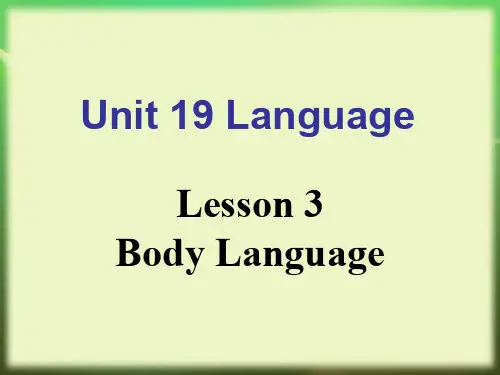
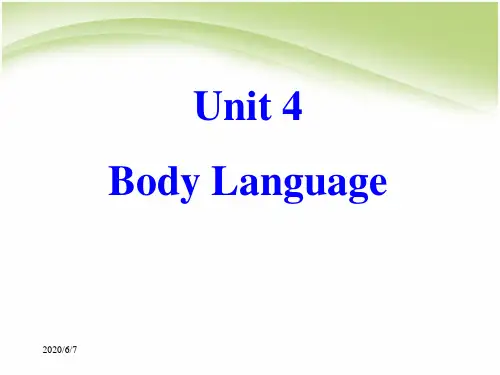
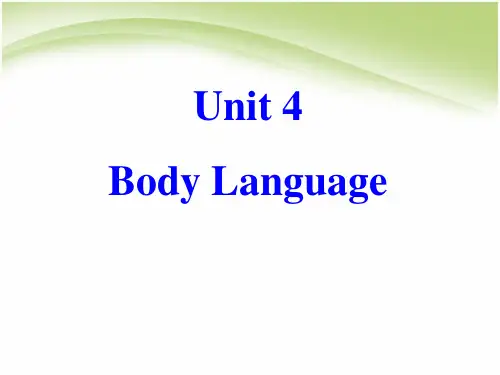
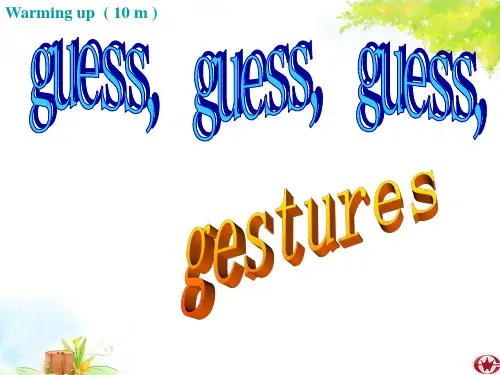
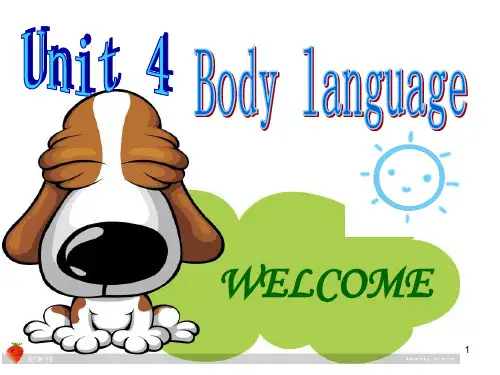

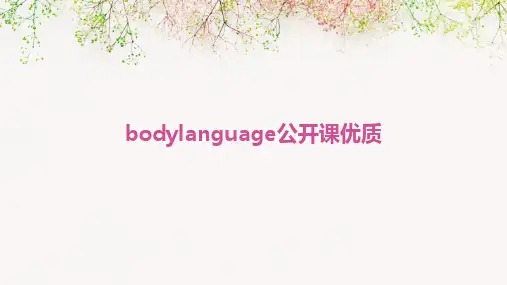
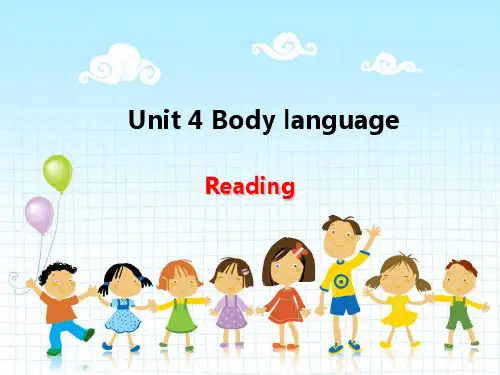
![body-language公开课[优质ppt]](https://uimg.taocdn.com/3696976267ec102de3bd8927.webp)
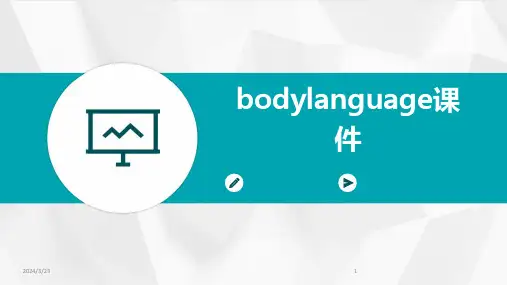
Unit 4 Body Language 教案1(COMMUNICATION: NO PROBLEM? <PART 1>) Teaching goals1. Target Languagea.重点词汇和短语misunderstand, similar, facial, expression, agreement, yawn, chest, gesture, adult, punishb.重点句型或交际用语Act out the following meanings, please.Please guess what I mean.Please show the actions, using body language.Now it is your turn to show the action / gesture.Please use either spoken words or body language to express your ideas.Please use both spoken words and body language to express your ideas.2. Ability goalsa. Enable the students to understand what a certain gesture of the body language means in a given situation.b. Enable the students to act out some meanings, requirements, requests or situations given in the target language.c. Enable the students to express with the target language the meanings given in body language.3. Learning ability goalsa. Help the students learn how to express themselves in body language when needed.b. Help the students understand others when body language is being used. Teaching important pointsa. Teach the students how to understand body language used in different countries or cultures as well as in different occasions.b. Teach the students how to use body language in the most appropriate occasions.Teaching difficult pointsa. Enable the students to realize the importance of body language in communication so that little or no misunderstanding may occur.b. Let the students know that there is both positive body language and negative body language.Teaching methodsa. Individual work, pair work and group work.b. Acting out by imitation, mime or with gestures and body movement.Teaching aidsA computer, a projector and some pictures.Teaching procedures & waysI. Warm up1. Play a song to the students and ask them to act to the music.If you’re HappyIf you’re happy and you know it, clap your hands.(clap, clap)If you’re happy and you know it, clap your hands.(clap, clap)If you’re happy and you know it, and you really want to show it.If you’re happy an d you know it, clap your hands.(clap, clap)2. Introduce gesturesT: Boys and girls, why not move our bodies to get relaxed. Let’s do it together! I will say some words and you will act their meanings out. First, raise your hands. Ready? Go! (The teacher says out the words as follow and the students do the gestures.)Well done!Victory!Stop!Quiet!3. Introduce the facial expressionsT: Good job! Now relax your face. Show the facial expression to express the following feelings.surprised angryfear joy4. Introduce the posturesT: Excellent! Now relax your whole bodies. We are going to move our whole bodies. You are expected to do the movement with your partners.nod bowhug handshake5. Introduce the eye contactT: Well done! Now use your eyes to express your feelings in the following situations. Situation one: Suppose today is your birthday, you receive a very big present. It’s as big as you. So when you see the present, what’s your response?(answer: wide eyed)Situation two: Suppose you are walking on the street, some ugly guy comes up to you and wants to talk to you to get your telephone number. What’s your response?(answer: roll eyes)Situation three: Suppose you are walking on the street, some handsome guy walks by you. What’s your response?(answer: wink)6. Summarize what’s body languageBody language is a form of communication without using any words and it can help us express our feelings. Now look at the pictures and guess what the man means by his body language?Come here!Bad!Good!Me?Good luck!I don’t know!II. Pre-reading1. Looking and sayingLook at the man in the picture below. What does he say to you by his body language?Basically, how the ... do I know? Or, I don’t know nothing! The shoulders are hunched and the hands are open signifying a big question mark.2. Talking and sharingBody language is the quiet, secret and most powerful language of all!According to experts, our non-verbal language communicates about 50% of what we really mean (voice tonality contributes 38%) while words themselves contribute a mere 7%.Our bodies send out messages constantly and often we don't recognize that we're communicating a lot more than we realize.Our understanding and use of non-verbal cues in facial expression are familiar to us nearly from birthIII. Reading1. Reading aloud to the recordingNow please listen and read aloud to the recording of the text COMMUNICATION: NO PROBLEM? Pay attention to the pronunciation of each word and the pauses within each sentence.I will play the tape twice and you shall read aloud twice, too.2. SkimmingT: First, I would like you to skim the text and find the names of the persons mentioned and the countries they come from. Time is limited to 2 minutes.Character(person) CountryYou ChinaMr. Garcia ColumbiaJulia Smith BritainMr. Cook CanadaA Japanese JapanAhmed Aziz JordanMadame Coulon France3. ScanningT: Now you have got all the characters in the text. For this time, I would like you to scan the text and find out the actions (body language) mentioned in the passage and then act them out in pairs. The following chart may help you find the movement. Time is limited to 4 minutes. Character(person) Country ActionsYou China First ________.Then _________ _________ when introducing yourself to Ahmed Aziz, you ____________ when he is very close.Mr. Garcia Columbia_________ Ms. Smith, _________ her shoulder and____________________.Julia Smith BritainJulia Smith ___________________ at Mr. Garcia’s action and____________________________.Mr. Cook Canada ____________________ to the Japanese.A Japanese Japan ____________ to Mr. Cook.Ahmed Aziz Jordan_____________ to you when introduced,_____________ to askquestions,__________ at women.Madame Coulon France ______________ each other twice on the cheek.Suggested answer:Character(person) Country ActionsYou China First stand, watching and listening. Then introduce guests when introducing yourself to Ahmed Aziz, you move back a little when he is very close.Mr. Garcia ColumbiaApproaches Ms. Smith, touches her shoulder and kisses her onthe cheek.Julia Smith BritainJulia Smith is surprised at Mr. Garcia’s action and takes a fewsteps away from him.Mr. Cook Canada Reaches his hand out to the Japanese.A Japanese Japan Bows to Mr. Cook.Ahmed Aziz Jordan Moves very close to you when introduced, comes closer to askquestions, nods at women.Madame Coulon France Shakes hands and kisses each other twice on the cheek.4. Intensive ReadingAsk the students to look through the questions on the screen and read the text silently. Students are expected to find out all the answers by themselves.T: OK, boys and girls. You have done a good job. Now let’s read paragraphs 2-3 and find out the mistakes by using different body languages. How do the mistakes happen? Time is limited to 4 minutes.After 4 minutes, ask the students whether they’ve got the answers.T: Now who would like to be the first one to tell me how many mistakes you have found?S1: There are two mistakes at the airport by using different body language.T: What’s the first mistake? And how does it happen?S2: Mr. Garcia from Columbia approaches Ms. Smith, touches her shoulder and kisses her on the cheek. Julia Smith from Britain steps back appearing surprised and takes a few steps away from Mr. Garcia.T: Good! Who would like to talk about the second mistake?S3: The second mistake happens between a Japanese and a Canadian. A Japanese bows to Mr. Cook and his nose touches Mr. Cook’s moving hand, when Mr. Cook from Canada reaches his hand out to the Japanese.T: Excellent! You have understood different body language in different cultures. Now let’s move on to paragraphs 3-6 and finish the following true or false exercise.1. Englishmen often stand close to others or touch strangers as soon as they meet.2. Most people around the world now greet each other by kissing.3. Japanese will bow to others as greeting.4. People from Jordan will move very close to you as you introduce yourself to them.5. Some body languages in some countries are good while some countries’ body languages are bad.Suggested answers:1.F2.F3.T4.T5.FIV. Closing down1. Closing down by doing exercisesTo end the lesson you are to do the comprehending exercises No. 1 and 2 on page 26 and 27.2. Closing down by checkingCheck some of the following basic non-verbal cues and you'll recognize that you already speak and translate much of the language.“I’m surprised!” “I’m shocked!” “I’m sad!”。